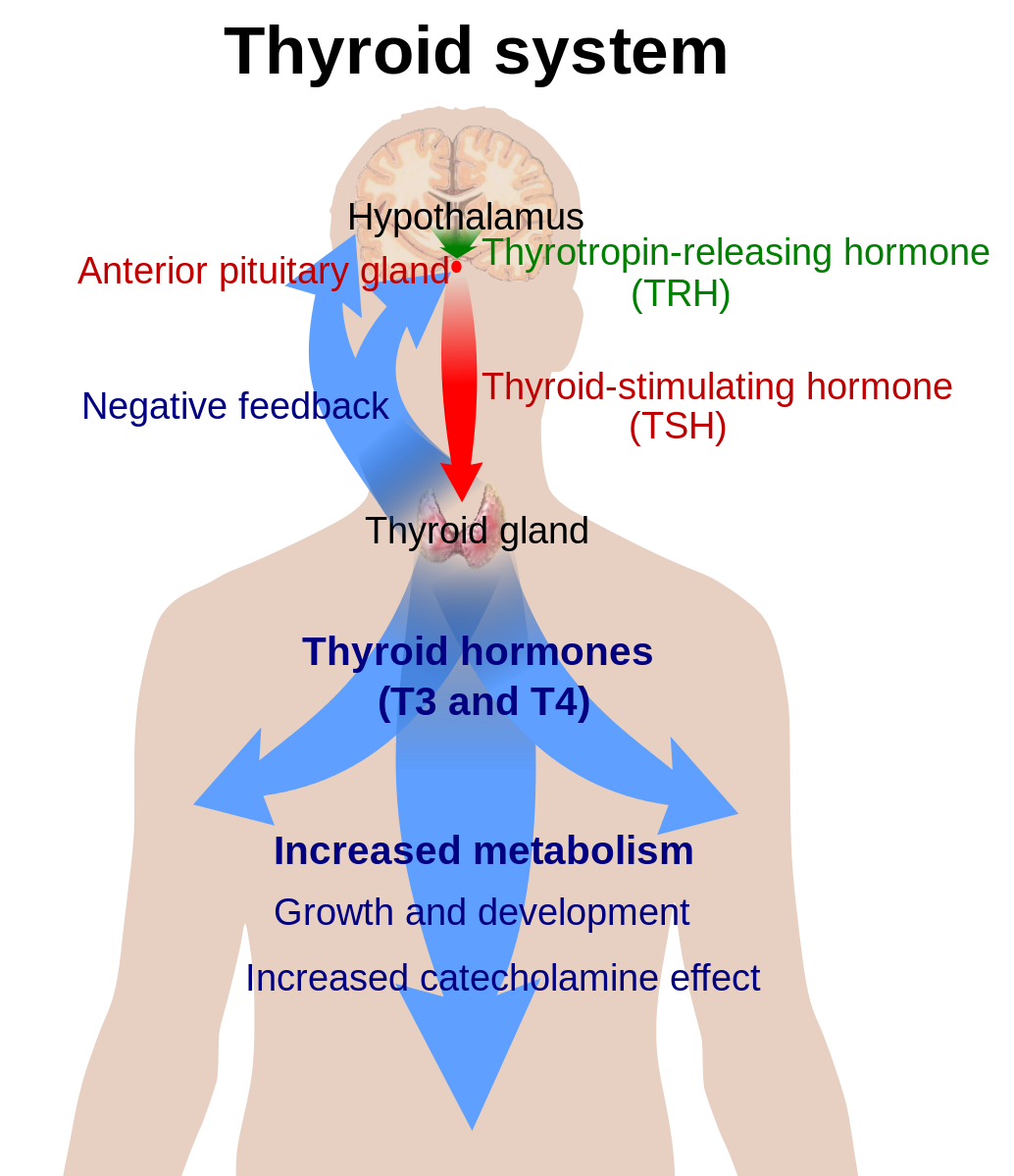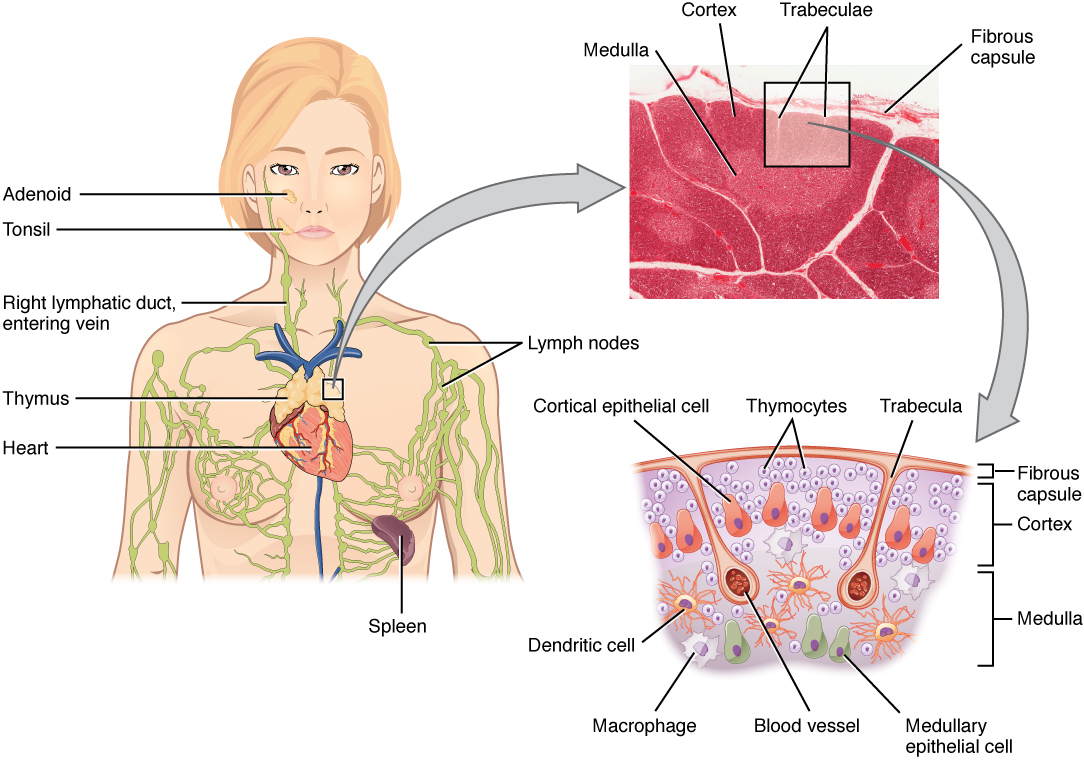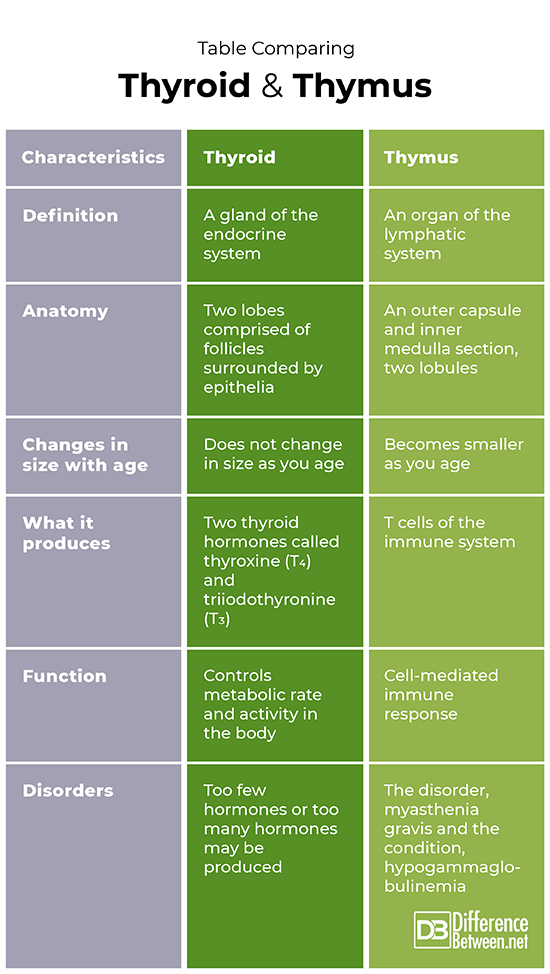Difference Between Thyroid and Thymus
The thyroid is a gland of the endocrine system that controls metabolism. The thymus is an organ that is involved in the immune response and is part of the lymphatic system.

What is Thyroid?
Definition:
The thyroid is an organ that is part of the endocrine system. It is a gland that produces two types of hormones that regulate metabolic rate in the body.
Structure:
The thyroid is found in a person’s neck and it can be divided into sections or lobes. The lobes consist of follicles that are surrounded by epithelia. It is in the follicles that hormones are made.
Function:
The thyroid produces two different hormones that are involved in controlling metabolism in the body. The hormones that are made are thyroxine (T4) and triiodothyronine (T3). They are formed from iodine molecules within each of the follicles of the thyroid.
Regulation:
The control of hormonal secretion from the thyroid is by actions of the anterior pituitary gland and the hypothalamus. These regions are both found in the brain with the activity controlled by a negative feedback loop. When there are too few thyroid hormones in the blood the hypothalamus is triggered. This then stimulates the release of thyrotropin-releasing hormone which triggers the anterior pituitary to secrete thyroid-stimulating hormone that stimulates the thyroid to, in turn, make and release the two thyroid hormones into the bloodstream.
Disorders:
In general, there are two problems that can occur with the thyroid gland, either there are too few thyroid hormones being made or there are too many thyroid hormones being made for whatever reason. In the case of too few hormones (an underactive thyroid), a person may have a sluggish metabolism and tend to gain weight; their hair may also become dry and brittle. A person who has an overactive thyroid, by comparison, often loses weight and has a rapid heart rate.

What is Thymus?
Definition:
The thymus is a triangular-shaped organ of the lymphatic system that is involved in the immune system response.
Structure:
The thymus is at its greatest size when a person is a fetus or baby and it slowly decreases in size as the person ages and when a person is very old this organ is greatly reduced in size. There is an outer capsule region and inner medulla region making up the thymus and the entire structure is divided into two parts which are called lobules. The thymus has cells known as reticulocytes as well as lymphocytes.
Function:
The function of the thymus is to protect the individual from pathogenic organisms such as viruses, particularly the developing fetus and newborn child. It is the site where white blood cells made in the bone marrow develop further into T-cells. There are several types of T cells which play various roles in cell-mediated immunity.
Regulation:
The production of immune system cells and maturation of cells in the thymus is controlled by a system which involves the hypothalamus of the brain and the pituitary gland. When a cell-mediated immune response is required, the brain can instruct the pituitary to send a signal to the thymus to produce more T cells.
Disorders:
Disorders of the thymus include the condition myasthenia gravis and hypogammaglobulinemia. Myasthenia gravis is when there is an enlarged thymus that produces antibody chemicals that attack the receptors of muscle cells.
Difference between Thyroid and Thymus?
Definition
The thyroid is an endocrine gland that produces hormones to regulate the metabolic rate in the body. The thymus is an organ of the lymphatic system where white blood cells develop further into T cells.
Anatomy
The thyroid gland consists of two lobes, each comprised of follicles surrounded by epithelia. The thymus consists of an outer capsule and inner medulla section and is made up of two lobules.
Changes in size with age
The thyroid does not change in size as you age unless there is a problem. The thymus does change in size and actually becomes smaller as you age.
What it produces
The hormones thyroxine and triiodothyronine are secreted by the thyroid gland. Mature lymphocytes called T cells are formed by and produced by the thymus from other white blood cells.
Function
The function of the thyroid gland is to regulate metabolism and metabolic rate. The function of the thymus is to produce T cells for the cell-mediated immune response.
Disorders
Thyroid problems include overproduction and underproduction of thyroid hormones. Thymus problems include myasthenia gravis and hypogammaglobulinemia.
Table comparing Thyroid and Thymus

Summary of Thyroid Vs. Thymus
- The thyroid is a gland that makes thyroid hormones.
- The hormones of the thyroid gland are both formed from iodine molecules in the colloid of the follicles.
- The thymus is an organ that produces T cells and is part of the lymphatic system.
- The T cells of the thymus are a type of lymphocyte which is involved in cellular mechanisms of immunity.
- Both the thyroid and thymus are regulated via the hypothalamus and the pituitary gland of the brain.
- The thyroid stays the same size throughout a person’s life span, while the thymus is only large during infancy and shrinks as a person ages.
- Difference Between Rumination and Regurgitation - June 13, 2024
- Difference Between Pyelectasis and Hydronephrosis - June 4, 2024
- Difference Between Cellulitis and Erysipelas - June 1, 2024
Search DifferenceBetween.net :
Leave a Response
References :
[0]Durkin, Helen G., and Byron H. Waksman. "Thymus and tolerance. Is regulation the major function of the thymus?" Immunological reviews 182.1 (2001): 33-57.
[1]Editors of Encyclopedia Britannica. "Thymus". Encyclopedia Britannica, 2019, https://www.britannica.com/science/thymus
[2]Mortensen, J. D., Lewis B. Woolner, and Warren A. Bennett. "Gross and microscopic findings in clinically normal thyroid glands." The Journal of Clinical Endocrinology & Metabolism 15.10 (1955): 1270-1280.
[3]Image credit: https://commons.wikimedia.org/wiki/File:2206_The_Location_Structure_and_Histology_of_the_Thymus.jpg
[4]Image credit: https://commons.wikimedia.org/wiki/File:Thyroid_system.svg
